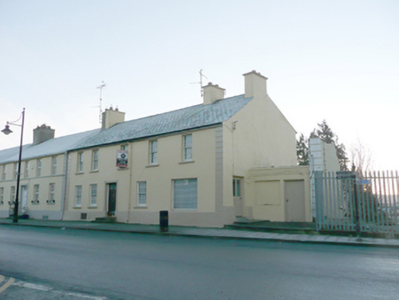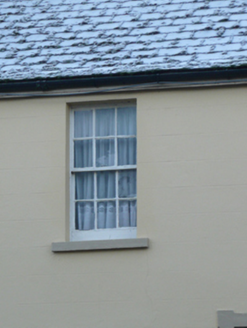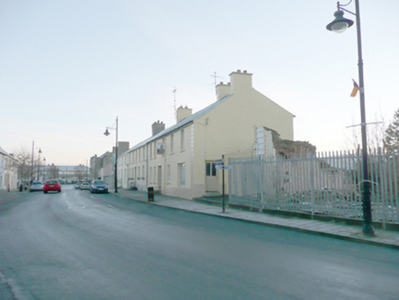Survey Data
Reg No
40835015
Rating
Regional
Categories of Special Interest
Architectural
Original Use
House
Historical Use
Shop/retail outlet
In Use As
House
Date
1790 - 1830
Coordinates
233462, 398442
Date Recorded
19/01/2011
Date Updated
--/--/--
Description
Attached end-of-terrace five-bay two-storey house, built c. 1870, having rear return to south-east, and with later single-storey addition attached to the south-west gable end. Later also in use as shop or retail outlet with enlarged window opening to the south-west end of the front elevation added c. 1950. Pitched artificial slate roof with projecting eaves course, smooth rendered chimneystacks to the gable ends, and cast-iron downpipes. Smooth rendered ruled-and-lined walls over projecting smooth rendered raised plinth course and raised smooth rendered parallel quoins to the corners. Square-headed window openings with painted stone sills and six-over-six pane timber sliding sash windows. Enlarged window opening to the south-west end of the front elevation having fixed-pane timber display window. Square-headed doorway with plain rendered surround and replacement door. Road-fronted to the south-west of the centre of Lifford, and to the south-wet of the Diamond.
Appraisal
This substantial and well-proportioned townhouse, probably originally dating to the turn of the nineteenth century, retains some of its original form and character despite some later alterations, including the insertion of a large fixed-pan display window to one end. The retention of the timber sliding sash windows adds to its visual appeal and integrity, and this building is one of the few to the centre of Lifford that retains sash windows. The irregular spacing of the openings creates a vernacular character that contrasts attractively with the more formal architecture surrounding the Diamond to the north-east. Although this building probably dates to the turn of the nineteenth century, the long low profile and the large chimneystacks to the gable ends suggests it might contain earlier fabric, perhaps c. 1750. This building makes a positive contribution to the streetscape to the south-west of the Diamond to the centre of Lifford, and is an addition to the built heritage of the town.





